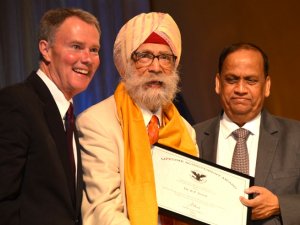A Prayerful Reflection
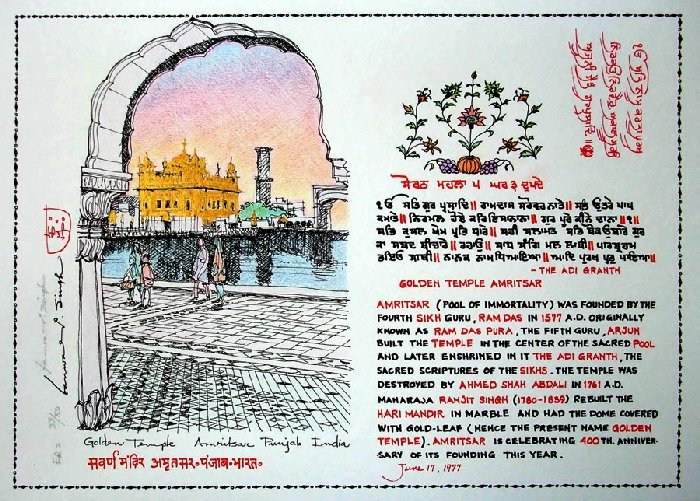 Commemorative drawing of Golden Temple Amritsar by KP Singh |
||||||||||||||||
|
Baisakhi is one of the most important and transforming events in the Sikh history, and this year marks its 315th commemoration. Besides its enormous religious significance as a landmark event in the Sikh history, Baisakhi heralds the beginning of harvest of wheat time in the State of the Punjab. The Punjab is the birthplace of the Sikh faith, one of the major religions founded in India; the others being Hinduism, Buddhism, and Jainism. Baisakhi is one of the major festivals on the Indian Calendar. Baisakhi generally falls in mid-April. The Festival and celebration of Baisakhi is one of the most joyous and colorful cultural festivals of India and is gradually becoming a major global cultural celebration. On this day, March 30, 1699, at the Baisakhi gathering at Anandpur Sahib, located in the foothills of Himalayan mountains, the Tenth Sikh Guru, Gobind Singh, organized the young Sikh faith into a formidable Brotherhood of Khalsa (an Army of the Pure, saints and soldiers). He organized a baptismal ceremony and invited the followers of Guru Nanak, the Sikh Founder, to embrace a distinct visual identity with five sacred articles of faith; to uphold the sacred and inalienable rights of equality, justice, human dignity of all living beings; to recognize all humanity as One Brotherhood, One Race. He advocated the sacred right of self-defense against tyranny, oppression, and injustice towards anyone. The Guru commanded his followers to bear arms and honor the five sacred articles of Sikh faith that included uncut hair covered with a turban and to carry the unifying last name of Singh (lion) for males and Kaur (princess) for female members of the Sikh Brotherhood.
Baisakhi 1699 became a remarkable moment in Sikh faith history and is regarded as a renewal, revival, and resurrection of a people that were beaten down by the events, foreign occupations, and tyranny of ruthless rulers of the time. Baisakhi of 1699 set in motion the emergence of a new fearless race of people. In time, the Sikhs became the legendary guardians and defenders of the Gateway to India, which for centuries was an open corridor to invading armies, hordes of Muslim, Mughal, and Mongol looters and plunderers of India's honor and fortune. Today, Sikhism is the fifth largest faith, with over 30 million followers worldwide, and nearly a million in the U.S.A. serving in every field of endeavor. Sikhs are hardworking, proud and robust, daring and innovative; people with strong family values and commanded to honor the sanctity of other faith traditions, cultures, and communities. Sikhs understand struggle and sacrifice, service and serving the nations and communities that are their new home. Throughout India and the Punjab and in the Sikh Diaspora spread across all continents today, much like Easter, Baisakhi is an occasion for family gatherings. Colorful parades with much pageantry and religious fervor highlight the days before the festival. People go on pilgrimages and attend prayer services at the holiest shrines decorated with festive lights and earthen lamps placed along the sacred pools associated with Sikh gurdwaras (temples). The festivities invariably include massive fireworks in the evening witnessed by enthusiastic throngs that number into hundreds of thousands, and the sacred compounds resound with popular Sikh jakaras (joyous acclamations). At the major Sikh historic gurdwaras, in some instances, laser displays have replaced the traditional fireworks. At the community and family Baisakhi celebrations, the festivities include traditional folkdances of Bhangra and Giddha, delicious Punjabi food and treats, dancing to the famous, robust, and rocking Punjabi music. In recent years, there has been a concerted effort to invite friends and honored guests from other faiths and ethnic communities to these annual cultural and religious celebrations. HARMANDER SAHIB OF THE SIKHS (THE GOLDEN TEMPLE) - AMRITSAR, INDIA  The magnificence and serenity of the Golden Temple complex at dusk. The Golden Temple is the spiritual center of the Sikh religion; the Temple is the St. Peter's Basilica of the Sikhs. People of all religions are welcome to visit the Golden Temple, and over 100,000 do so each day. On festivals such as Baisakhi, over 250,000 people may visit the Golden Temple. People come to pray, to witness a monotheistic faith at its holiest shrine that has been a witness to much history; work in the community kitchen that serves a free meal to all who visit to the Temple and wish to partake.
The Golden Temple is a beautiful example of when sacred architecture becomes a testimony of celestial splendor. It gives us pause about the history of this monument, holiest of holy to the Sikhs, a place of bliss for everyone who arrives here for prayer, with a petition, or with a spirit to learn about the tradition of a major world religion. This magnificent edifice, the Golden Temple at Amritsar, embodies all that and much more as a world spiritual center. For the Sikhs, the Golden Temple is their heart and soul: a place that has witnessed the history of their faith, sacrifices of countless to defend its sanctity. Visiting the Golden Temple reinforces their faith and commitment to the sacred commandments of equality, justice, dignity of all One God's children. Sikhism has reverberated with the message of sanctity of all faith traditions as our collective spiritual treasure and service of humanity.
At this place, the sacred Scripture of the Sikhs was installed by the Fifth Sikh Prophet, Guru Arjan Dev in 1604 A.D. Associated with the lives of other Sikh Gurus, the foundation stone of this Temple was laid by a venerated Sufi Saint, Hazrat Mian Mir, in 1588 A.D. The Temple was richly adorned and embellished by Maharaja Ranjit Singh in the nineteenth century. This sacred complex is associated with celebrated martyrs who gave up their lives in righteous defiance and for the defense of this magnificent Harmander Sahib: 'The Temple of God' surrounded by a 'Pool of Immortality' and anchored by The Akal Takht: 'The Throne of God.'
This majestic heritage site is rich with history and tradition. This is hallowed ground for all humanity. This place is alive with pilgrims of faiths from the remotest corners of earth. The Golden Temple is an exquisite example of Indo-Sarsenic architecture and radiates a celestial aura. The sacred Sikh music emanating daily from inside the Golden Temple, from before dawn until late into the evening, fills the air with blessings and praise of the Divine. The music, melody, and Ragas (patterns of music), universal message, serene beauty, and warm spirit of the place seem to transcend all differences, embraces people of diverse cultures, languages, national origins, and other rich traditions into folds of seamless spiritual bliss. The arts, architecture, the ceremonial walkway surrounding the sacred pool, memorial structures and markers, grand entrances to the complex, the gilded facades and domes, marble columns, walls decorated with frescoes and ceilings inlaid with precious stones, all mirror an image of sacred splendor that is breathtaking and all-embracing, manifesting a spirit of unity, universality, and our shared humanity. Here architecture embodies something immeasurably enlightened and reaffirming to the human spirit. The architecture, arts, the sacred aura enshrined within and radiating throughout the surrounding space of the famous Darbar Sahib: 'The Court of the Lord,' makes the word spiritual Grace manifest. The serene environment uplifts our thoughts and prayers as we witness before us a rare architectural gem in living color, and a captivating scene of indescribable majesty etching a lasting imprint on the human soul. Visitors at Gurdwara Bangla Sahib in Delhi, India Visitors at Bangla Sahib Gurdwara, New Delhi  Gurdwara Bangla Sahib drawing by KP Singh Takht Sri Keshgarh Sahib Gurdwara at Anandpur Sahib, India
REFLECTING ON BAISAKHI MESSAGE AND LESSON <><><><><><><> Baisakhi text and photographs by Kanwal Prakash (KP) Singh, Indianapolis, Indiana USA |
| KANWAL PRAKASH SINGH
KP has been a tireless advocate and supporter of historic preservation, cultural diversity, and the importance of arts to life and human spirit. KP considers community service as a major focus and commitment of his Sikh faith and as a civic responsibility. Over the years, he has served as a volunteer on many committees and events. KP is a founding member of The International Center of Indianapolis and serves as a Board Member of the Asian American Alliance; Advisory Board of Brooke’s Place for Grieving Young Persons, Butler University Center on Faith and Vocation, Center for Interfaith Cooperation, Race and Cultural Relations Leadership Network, Indianapolis Civilian Police Merit Board, 2011 FBI Citizens Academy graduate, and other professional and educational institutions. KP participates in interfaith and humanitarian initiatives (Interfaith Hunger Initiative); activities and celebrations of diverse faiths and ethnic communities in Indiana. KP assists with cultural training for Police Officers and TSA personnel; works with teachers, students, civic leaders to create a better understanding of Sikh faith traditions and contributions. KP advocates interfacing and mainstreaming ethnic talents, assets to benefit all Americans. KP is a recipient of many awards and honors: The Daverman Award in Architecture (University of Michigan -1965); The Sagamore of the Wabash (State of Indiana - 1992); International Citizen of the Year (International Center of Indianapolis - 1995); Award of Excellence in Arts (Asian American Alliance - 2002); USA NRI Who’s Who (NRIinternet.com - 2004); Miri Piri Award (The Sikh Heritage Foundation of California - 2006); “Men of Distinction” recognition (Indiana Minority Business Magazine - 2008); Sarah Lewis Lifetime Achievement Award (United Way of Central Indiana - 2010); Dr. Bhagat Singh Thind Community Empowerment Award (SALDEF - 2010); Creativity Focus Award (SAFF-2010); Wilbur Peat Award for Outstanding Contribution and Appreciation of Indiana’s Architectural Heritage (Society of Architectural Historians - 2011); Spirit of Baisakhi Award (Los Angeles – 2011); Hoosier Heritage Lifetime Achievement Award (Heritage Place - 2011); featured in Indianapolis Super Bowl XLVI Faces Project (February 2012); FBI Director’s Community Leadership Award (November 2013). K.P. Singh Designs, founded in 1972, specializes in fine arts. KP's distinctive, finely executed pen and ink drawings of historic architecture and monuments in India, Europe, USA, and other places reflect the combined skills of an architect, artist, historian, and an educator. His art and advocacy have continued to heighten our awareness of the special place of significant buildings and sites in the visual, cultural, and spiritual fabric of our communities. KP's drawings of architectural landmarks: Indiana courthouses, colleges, places of worship, and other historic sites are present at many fundraising events and his artwork is in many public and private collections in the USA and around the world. His drawings of sacred places of major faiths were featured in the 2007 and 2011 SikhLens-Sikhpoint Interfaith Calendar. In 2007, three of KP’s original drawings were installed in The Sikh Heritage Gallery at The Museum of Natural History, Smithsonian Institution in Washington, D.C. KP's art and words are a constant reminder of his passion and commitment to preservation and celebration of our unique and outstanding architectural, artistic, and cultural treasures as the collective heritage of human civilization. His art and writings featured in several print and online ethnic newspapers, newsmagazines, and other publications offer diverse perspectives and reflect his serious interest in the matters of spirit. KP’s book, The Art and Spirit of K.P. Singh ~ Selected Drawings and Writings (Guild Press - Emmis Publishing, 2003), offers a rich sampling of his writings and drawings. His writings reveal cultural insights, personal journey, and respect for diverse ideas and inspirations; universal and common human struggles and triumphs; cultural advocacy and inalienable rights; study, learning, networking, and serving to enhance our collective promise. KP is a frequent guest speaker and participant in community, cultural and interfaith events and celebrations. For additional information, visit: www.KPSinghDesigns.com |

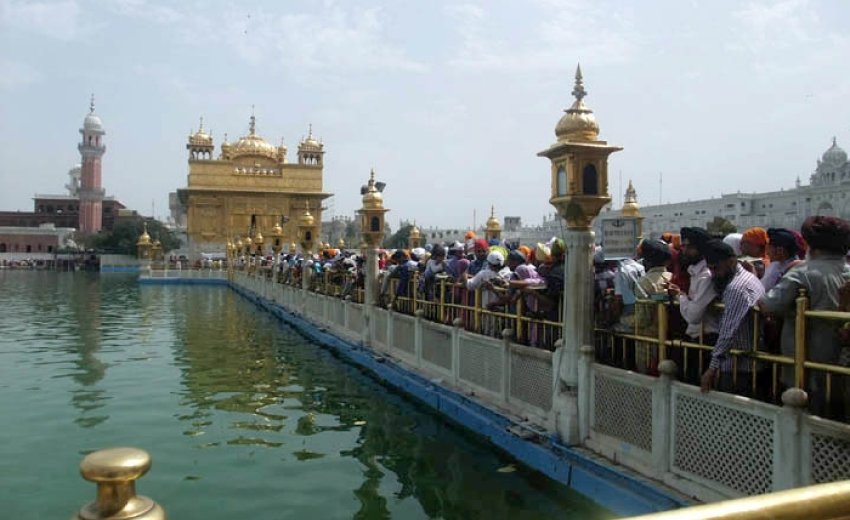

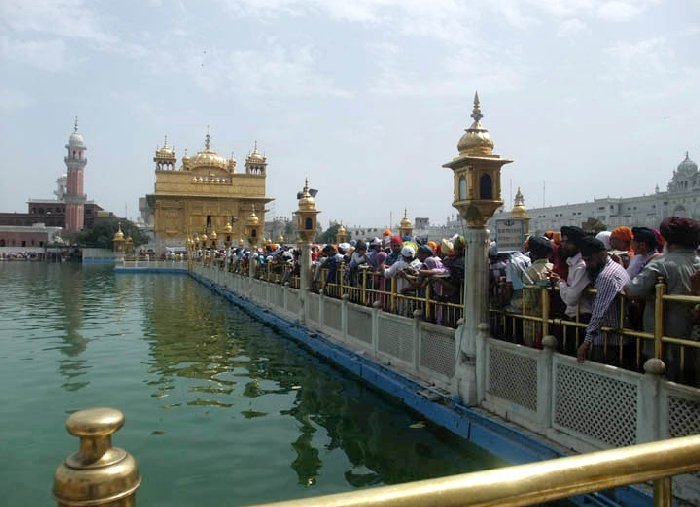
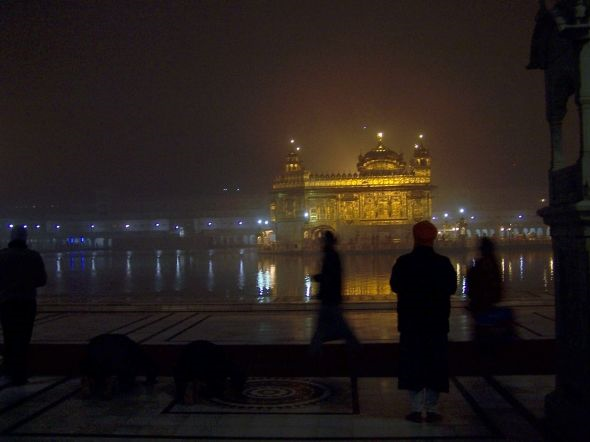

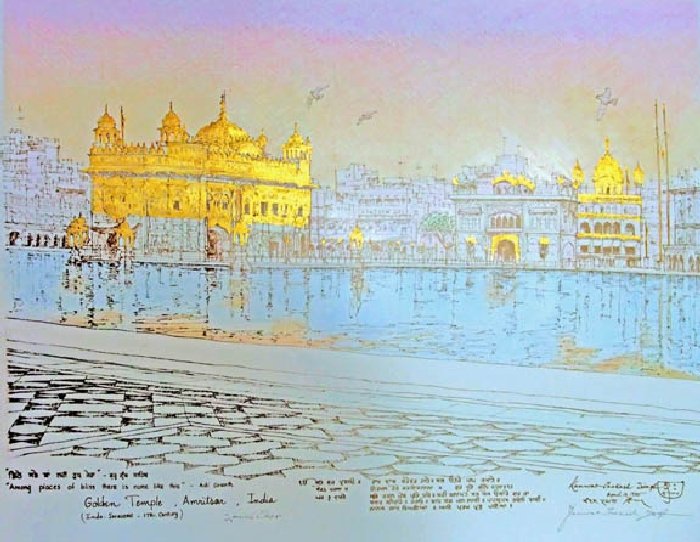

 Born in India, Kanwal Prakash (KP) Singh came to the United States in 1965 for higher studies. He has made Indianapolis his home since 1967. KP was educated in India (B.A. from Punjab University; Bachelor of Architecture and Master of Technology in Regional Planning from The Indian Institute of Technology, Kharagpur) and the United States (Master of City Planning from The University of Michigan).
Born in India, Kanwal Prakash (KP) Singh came to the United States in 1965 for higher studies. He has made Indianapolis his home since 1967. KP was educated in India (B.A. from Punjab University; Bachelor of Architecture and Master of Technology in Regional Planning from The Indian Institute of Technology, Kharagpur) and the United States (Master of City Planning from The University of Michigan).


